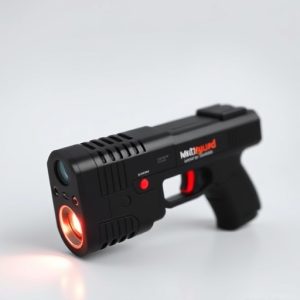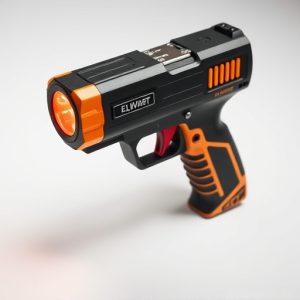Multiguard Stun Gun: Legal Regulations & Safety Guide for Concealed Carry
Complying with local laws regarding concealed carry of Multiguard stun guns is vital for self-defens…….
Complying with local laws regarding concealed carry of Multiguard stun guns is vital for self-defense. Regulations vary by jurisdiction, dictating permit types, age limits, background checks, and device specifications. Understanding these laws ensures citizens can legally protect themselves while respecting public safety. The Multiguard Stun Gun offers high-voltage shocks, LED flashlights, and ergonomic design for maximum effectiveness in deterring threats. Before concealing it, thoroughly research local regulations on non-lethal weapon carry, including specific models like the Multiguard. Adhering to best practices includes safe storage, regular training, awareness, understanding legal limits, and viewing stun guns as part of a comprehensive personal safety strategy.
In today’s unpredictable world, personal safety is paramount. For those seeking proactive protection, concealed carry stun guns offer a compelling solution. This comprehensive guide explores the intricate web of regulations surrounding concealed carry, focusing on the Multiguard Stun Gun—its unique features and benefits. We’ll navigate legal considerations, ensuring you understand the do’s and don’ts before concealing a stun gun. Discover best practices for legal and safe carrying, empowering yourself with knowledge in an ever-changing landscape.
- Understanding Concealed Carry Laws: A Comprehensive Overview
- Multiguard Stun Gun: Features and Benefits for Personal Safety
- Legal Considerations: What You Need to Know Before Concealing a Stun Gun
- Ensuring Safety and Compliance: Best Practices for Carrying a Stun Gun Legally
Understanding Concealed Carry Laws: A Comprehensive Overview
Understanding the laws surrounding concealed carry, such as those governing the use of a multiguard stun gun, is paramount for any individual seeking to protect themselves or others. These regulations vary widely across jurisdictions, making it essential to research and comply with local, state, and federal guidelines. A comprehensive review of these laws ensures that citizens can exercise their right to self-defense while adhering to legal parameters.
Many areas have specific requirements regarding permit types, age restrictions, background checks, and the type of stun device allowed. For instance, a multiguard stun gun may be permitted in certain locations but subject to size, power output, and other technical specifications. Staying informed about these details empowers individuals to make informed decisions, ensuring they possess the appropriate self-defense tool for their needs while respecting the legal framework designed to maintain public safety.
Multiguard Stun Gun: Features and Benefits for Personal Safety
The Multiguard Stun Gun is a powerful personal safety tool designed to offer multiple layers of protection in various scenarios. Its key feature is the ability to deliver a strong electrical shock, incapacitating an attacker for a crucial period, allowing the user to escape or seek help. This stun gun combines advanced technology with a sleek and compact design, making it easily concealable and suitable for everyday carry.
Benefits of the Multiguard Stun Gun include its high-voltage output, which ensures maximum effectiveness in deterring potential threats. The device also features a built-in LED flashlight, providing illumination in low-light conditions or during an emergency. Its ergonomic grip and simple activation mechanism make it user-friendly, ensuring that individuals of various skill levels can operate it effectively when needed.
Legal Considerations: What You Need to Know Before Concealing a Stun Gun
Before considering concealing a stun gun, it’s crucial to understand the legal landscape surrounding concealed carry regulations in your area. Each jurisdiction has its own set of rules and restrictions when it comes to owning and carrying stun devices, often referred to as non-lethal weapons or personal protection tools like the Multiguard stun gun. These laws can vary greatly from state to state, and even within different counties or cities within a single state.
One key consideration is whether your region permits the concealed carry of any kind of stun device or if specific models, like the Multiguard stun gun, are approved for hidden carrying. Some areas have strict restrictions on the size, power, and overall design of stun guns, while others may have looser regulations. Additionally, there might be requirements for permit acquisition, background checks, training certifications, or specific storage methods to comply with local laws. It’s essential to stay informed about these legal considerations to ensure you’re following all applicable rules and regulations.
Ensuring Safety and Compliance: Best Practices for Carrying a Stun Gun Legally
When carrying a stun gun for self-defense, it’s paramount to prioritize safety and comply with local regulations. Different regions have distinct rules regarding concealed carry permits, so ensuring you’re familiar with and adhere to these laws is crucial. For instance, some areas mandate specific types of stun guns, like the multiguard stun gun, which offers advanced safety features such as automatic shut-off mechanisms and adjustable voltage settings.
Best practices include maintaining a safe storage method for your stun gun at all times, ensuring it’s easily accessible yet not visibly displayed to avoid drawing unnecessary attention. Regularly updating your knowledge on local legislation and attending training sessions to learn proper usage techniques can also enhance safety. Always be aware of your surroundings, know the legal limits of self-defense, and remember that a stun gun is just one tool in your personal safety arsenal.
In conclusion, the regulation of concealed carry stun guns varies across jurisdictions, but understanding the legal framework and choosing the right tool, like the Multiguard Stun Gun, can significantly enhance personal safety. Always ensure compliance with local laws and follow best practices for safe carrying. Armed with knowledge and the right equipment, individuals can protect themselves effectively while navigating complex regulations.


